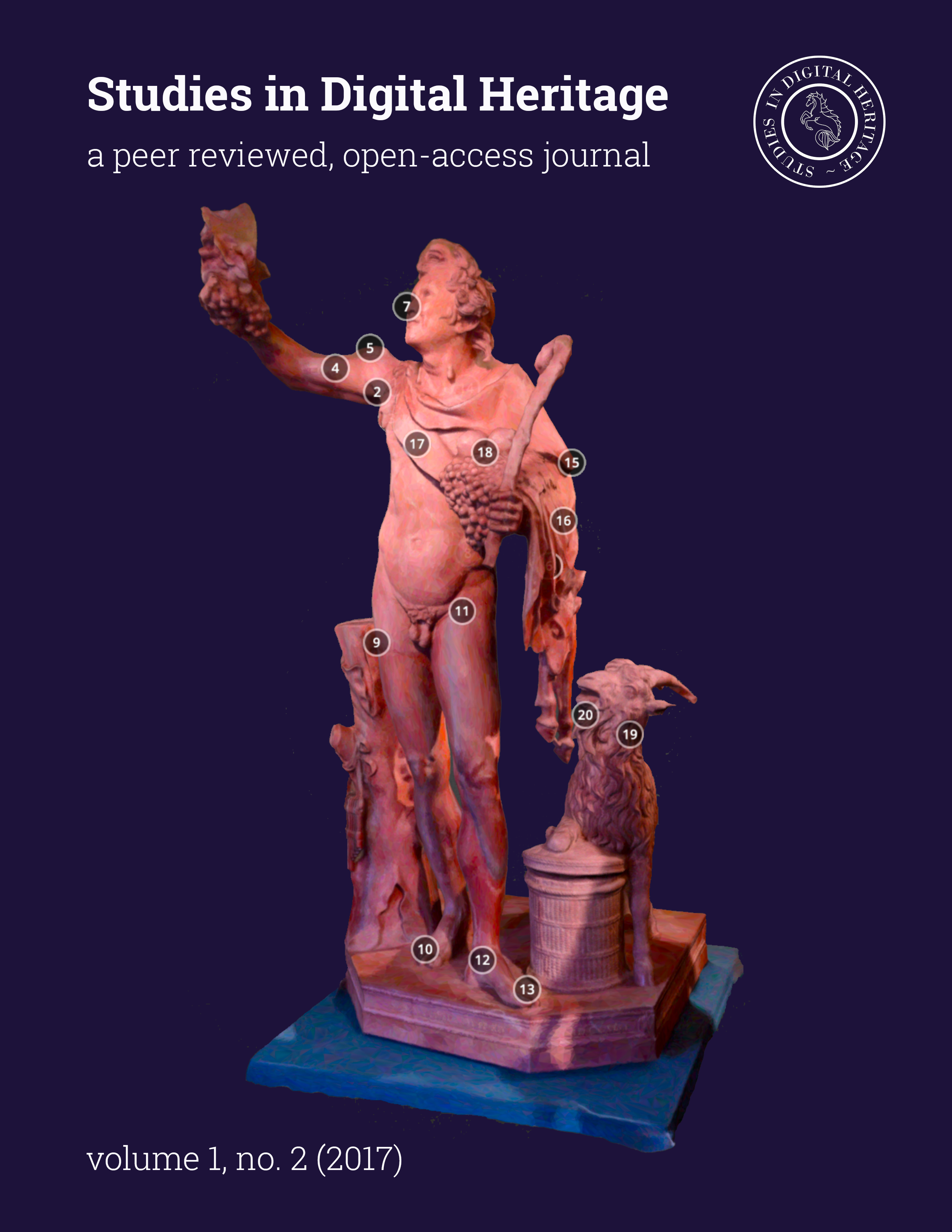From Reconstruction to Analysis. Re-use and re-purposing of 3D scan datasets obtained from ancient Greek marble sculpture
Main Article Content
Abstract
The paper describes two related research projects concerning the sculptural decoration of a well-known classical Greek monument, the temple of Zeus at Olympia. Both projects are based on the same dataset, i.e. the 3D scans obtained from the original pieces of marble sculpture, but they are used for two completely different purposes. In the first section, a summary is given of the results concerning the virtual 3D reconstruction of the east pediment, the second part describes another research question, the identity of the so-called Olympia master and a new analytical method, which makes use of the possibilities offered by the digital datasets and may open up new perspectives for the traditional art historical analysis. Beside the re-using and re-purposing of the raw data, the 3D models are not the final output of the project, but they are used to enhance our knowledge in a new way, which would be hardly feasible with traditional methods.
Downloads
Article Details
From 18 May 2018, the contents of Studies in Digital Heritage are licensed under a Creative Commons Attribution-NonCommercial 4.0 International License (CC BY-NC 4.0). Our submitting authors pay no fee and retain the copyright to their own work.
How this works: to submit their work to the journal, authors grant Studies in Digital Heritage a nonexclusive license to distribute the work according to a CC BY-NC 4.0 license. Once an article is published, anyone is free to share and adapt its contents—provided only that they do so for noncommercial purposes and properly attribute the shared or adapted information. Details of these terms can be found on the Creative Commons website.
Download SDH’s full author agreement here
Studies in Digital Heritage will insert the following note at the end of any work published in the journal:
© [Year] by the authors. This article is an open-access article distributed under the terms and conditions of the Creative Commons Attribution License CC BY-NC 4.0 (https://creativecommons.org/licenses/by-nc/4.0/).
References
Amyx, D. A. (1988) Corinthian vase-painting of the archaic period, I-III., Berkeley: University of California Press.
Beazley, J. D. (1947) Etruscan vase-painting. Oxford: Oxford University Press.
Beazley, J. D. (1956) Attic black-figure vase-painters. Oxford: Oxford University Press.
Beazley, J. D. (1963) Attic red-figure vase-painters. Oxford: Oxford University Press.
Beazley, J. D. (1971) Paralipomena. Oxford: Oxford University Press.
Bulle, H. (1939) Der Ostgiebel des Zeustempels zu Olympia, Jahrbuch des Deutschen Archäologischen Instituts 54: 137–218.
Dörig, J. (1997) The Olympia Master and His Collaborators. Leiden: Brill.
Frel, J. (1969) Les sculptures attiques anonymes, 430 – 300. Praha: University Karlova.
Frischer, B. (2015). The-Dimensional Scanning and Modeling. In Elise A. Friedland, Melanie Grunow Sobocinski, and Elaine K. Gazda, ed. The Oxford Handbook of Roman Sculpture (Oxford University Press, Oxford, 2015), 74-92.
Grunauer, P. (1981) Zur Ostansicht des Zeustempels, in: Alfred Mallwitz (ed.), X. Bericht über die Ausgrabungen in Olympia. Frühjahr 1966 bis Dezember 1976, Berlin: De Gruyter, 256-301.
Herrmann, H.-V. ed. (1987) Die Olympia Skulpturen. Darmstadt: Wissenschaftliche Buchgesellschaft.
Holloway, R. R. (2000) The Master of Olympia: the Documentary Evidence. http://www.brown.edu/Departments/Joukowsky_Institute/publications/papers/olympia/olympi a.html (accessed 29/01/2017)
Kyrieleis, H. (2006) Paros und Olympia. Zu den Skulpturen des Zeustempels in Olympia. In: Γενεθλιoν. Aναµνηστικός τόµoς για την συµπλήρωση είκoσι χρόνων λειτoυργίας τoυ Moυσείoυ κυκλαδικής τέχνης, Athens: Goulandris Museum of Cycladic Art, 183-201.
Oakley, J. H. (1998) Why study a Greek vase-painter? A response to Whitley’s “Beazley as theorist”. Antiquity 72, 209-213.
Patay-Horváth, A. (2011) The Virtual 3D Reconstruction of the East Pediment of the Temple of Zeus at Olympia, Budapest (CD ROM: ISBN 978-963-284-196-0)
Patay-Horváth, A. (2013) The Virtual 3D Reconstruction of the East Pediment of the Temple of Zeus at Olympia - An old puzzle of classical archaeology in the light of recent technologies, Digital Applications in Archaeology and Cultural Heritage Vol. 1, 2012, 12-22.
Patay-Horváth, A. (2016) Master-Hand Attributions of Classical Greek Sculptors by 3D-Analysis at Olympia - Some Preliminary Remarks, in: S. Campana, R. Scopigno, G. Carpentiero & M. Cirillo (eds) 2016. CAA 2015 KEEP THE REVOLUTION GOING. Proceedings of the 43rd Annual Conference on Computer Applications and Quantitative Methods, Oxford: Archaeopress, 329-336.
Säflund, M. L. (1970) The East Pediment of the Temple of Zeus at Olympia. A Reconstruction and Interpretation of its Composition. Göteborg: P. Åström.
Sengoku-Haga K.et al. (2015) Polykleitos' Works "From One Model": New Evidence Obtained From the 3D Digital Form Comparisons, In: Patay-Horváth, A. (ed) New Approaches to the Temple of Zeus at Olympia, 201-222.
Stibbe, C. M. (1972) Lakonische Vasenmaler des sechsten Jahrhunderts v.Chr. Amsterdam: NorthHolland Publishing.
Studniczka, F. (1923) Die Ostgiebelgruppe vom Zeustempel in Olympia, Abhandlungen der Sächsischen Akademie der Wissenschaft, Phil.-Hist. Klasse 37: 3-36.
Szilágyi, J. GY. (1998) Ceramica etrusco-corinzia figurata, 1-II. Firenze: Olschi.
Trendall, A. D. (1967) The red-figured vases of Lucania, Campania and Sicily, Oxford: Oxford University Press.
Trendall, A. D. (1982) The red-figured vases of Apulia I-II. Oxford: Oxford University Press.
Treu, G. (1897) Olympia III. Bildwerke aus Stein und Thon. Berlin.
Vakkari, J. (2001) Giovanni Morelli’s ‘Scientific’ Method of Attribution and its Reinterpretations from the 1960’s until the 1990’s. Konsthistorisk Tidskrift 70/ 1-2: 46-54.
Whitley, J. (1997) Beazley as theorist. Antiquity 71: 40-47.


